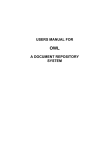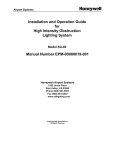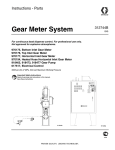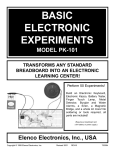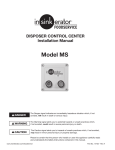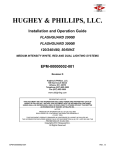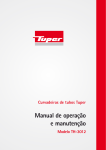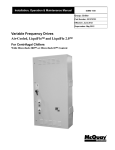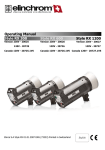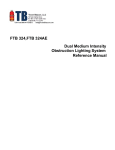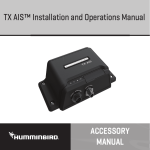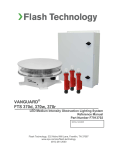Download Um0010 - Hughey & Phillips
Transcript
HUGHEY & PHILLIPS, LLC. Installation and Operation Guide SS-122/125 HIGH INTENSITY WHITE STROBE SYSTEM MANUAL UM0010 Revision M Hughey & Phillips, LLC. 136 East Court Street Urbana, OH 43078 Telephone (937) 652-3500 Fax (937) 652-3508 www.oblighting.com PROPRIETARY NOTICE THIS DOCUMENT AND THE INFORMATION DISCLOSED HEREIN ARE PROPRIETARY DATA OF HUGHEY & PHILLIPS INC. NEITHER THIS DOCUMENT NOR THE INFORMATION CONTAINED HEREIN SHALL BE REPRODUCED, USED, OR DISCLOSED TO OTHERS WITHOUT THE WRITTEN AUTHORIZATION OF HUGHEY & PHILLIPS INC. NOTICE FREEDOM OF INFORMATION ACT (5 USC 552) AND DISCLOSURE OF CONFIDENCE INFORMATION GENERALLY (18 USC 1905) THIS DOCUMENT IS BEING FURNISHED IN CONFIDENCE BY HUGHEY & PHILLIPS INC. THE INFORMATION DISCLOSED HEREIN FALLS WITHIN EXEMPTION (b) (4) OF 5 USC 552 AND THE PROHIBITIONS OF 18 USC 1905. Copyright 2010 All Rights Reserved UM0010 Rev. M REVISIONS REV DATE ECO COMMENT A-L To – 10/99 Varies Reference ECO Files M 3/25/10 Company Name Change WARRANTY POLICY For current warranty policy please visit www.oblighting.com UM0010 Rev. M TABLE OF CONTENTS History Revisions…………………………………………………………………………….…2 Page of TABLE OF CONTENTS .................................................................................................................3 SECTION 1 - GENERAL INFORMATION ...................................................................................4 1.1 Scope .....................................................................................................................................4 1.2 General Description ..............................................................................................................5 1.3 Safety Precautions.................................................................................................................6 SECTION 2 - INSTALLATION .....................................................................................................7 2.1 2.2 2.3 2.4 Unpacking .............................................................................................................................7 Mounting and Preparation ....................................................................................................7 Installation Wiring ..............................................................................................................10 General Installation Notes ..................................................................................................14 SECTION 3 - OPERATION ..........................................................................................................14 3.1 Operating Considerations ...................................................................................................14 3.2 Controls and Indicators .......................................................................................................16 3.3 Normal Operation ...............................................................................................................19 SECTION 4 - PRINCIPLES OF OPERATION ............................................................................20 4.1 Overall Description .............................................................................................................20 4.2 Functional Description of Subsystems ...............................................................................20 SECTION 5 - TROUBLESHOOTING..........................................................................................38 5.1 All Lights Are Out ..............................................................................................................38 5.2 One Tier Of Lights Is Out. ..................................................................................................39 5.3 One Light Is Out. ................................................................................................................39 5.4 All Lights Are Flashing Out Of Synchronism. ...................................................................39 5.5 One Light Is Flashing Out Of Synchronism. ......................................................................40 5.6 One Tier Is Out Of Synchronism; All Lights Are On.........................................................40 5.7 Continuous Day, Twilight, Or Night Mode; All Lights. ....................................................40 5.8 Continuous Day, Twilight, Or Night Mode; One Light. ....................................................40 5.9 Single Low Intensity Flash In Night Operation Of One Light. ..........................................40 5.10 Frequent Fuse Blowing In The Owl. ................................................................................41 5.11 Frequent Fuse Blowing In The Controller. .......................................................................41 SECTION 6 - MAINTENANCE ...................................................................................................41 6.1 SS125 Obstruction Warning Light (OWL) ........................................................................41 6.2 SS122 Controller...........................................................................................................42 6.3 SS124 Ambient Light Sensor........................................................................................42 SECTION 7 - SPARE PARTS LIST .............................................................................................43 UM0010 Rev. M SECTION 1 - GENERAL INFORMATION 1.1 Scope This manual provides information about the installation, operation, and maintenance of the Type LS-158 High Intensity Obstruction Lighting System, StrobeGuard*, an FAA Type A system for use on structures such as chimneys and towers, developed and manufactured by Hughey & Phillips, LLC, 136 East Court Street, Urbana, OH 43078, tel. (937) 652-3500, FAX (937) 6523508. *Registered Hughey & Phillips Trademark UM0010 Rev. M 1.2 General Description The Type LS-158 Lighting System is a capacitor discharge, xenon flash strobe light system of Flashhead/Power Supply units manufactured to comply with Federal Aviation Administration Advisory Circular 150/5345-43 and hereinafter referred to as Obstruction Warning Lights (OWLs). The Controller and the Ambient Light Sensor supply the various control functions for all the lights on a single installation. Table 1-1 lists the equipment supplied with the Type LS-158 System, noting those that are optional. The installer and/or user should refer to their specific order to determine those options that apply to the installation. Any optional items, when ordered, are assembled into the basic unit at the factory. Table 1-1. EQUIPMENT SUPPLIED Flashhead/Power Supply Subsystem (OWL) Enclosure, 304 Stainless Steel Elevation Mounts Louvers* Interconnection Cable (77-4231), 15 ft. Other lengths Optional 50Hz Operation* SS125 Controller Subsystem Enclosure, 304 Stainless Steel Transformer, Isolation, and Step-down for other than 120VAC, 60Hz operation Audio Fault Alarm* SS122 Ambient Light Sensor (3-level) Enclosure, Molded Fiberglass SS124 *optional The flashhead portion of the SS125 OWL consists of a flashtube, a reflector and a high voltage trigger transformer. The same enclosure also contains the power supply control circuits (relays, fuses, switches, etc.), a high voltage circuit (power transformer, rectifiers, energy storage capacitors, discharge relays and resistors), a monitoring transmitter circuit and a trigger generator. The SS122 Controller contains control AC power for mode relays, flash interval and timing circuits, intensity selection controls, and monitoring receivers with status indicators. The SS124 Ambient Light Sensor contains two photocells and a switching circuit. UM0010 Rev. M 1.3 Safety Precautions The following general safety precautions must be observed during all phases of operation, service, and repair of this equipment. Failure to comply with these precautions or with specific warnings elsewhere in this manual violates safety standards of design, manufacture, and intended use of this equipment. Hughey & Phillips assumes no liability for the customer's failure to comply with these requirements. 1. Any interruption of the protective (grounding) conductor (inside or outside the instrument) or disconnecting the protective earth terminal is likely to make this equipment dangerous. Intentional interruption is prohibited. 2. Whenever it is likely that the protection has been impaired, the equipment must be made inoperative and be secured against any unintended operation. 3. Ensure that only fuses with the required rated current and of the specified type (normal blow, time delay, etc.) are used for replacement. The use of repaired fuses and the short-circuiting of fuseholders must be avoided. 4. Adjustments described in the manual are performed with power supplied to the equipment while protective covers are removed. Energy available at many points may, if contacted, result in personal injury. 5. Any adjustment, maintenance, and repair of the opened equipment under voltage should be avoided as much as possible, and when inevitable, should be carried out only by a skilled person who is aware of the hazard involved. Do not attempt internal service or adjustment unless another person, capable of rendering first aid and resuscitation, is present. Do not replace components with power cable connected. 6. Do not install substitute parts or perform any unauthorized modification to the equipment. 7. Capacitors inside the equipment may still be charged even if the instrument has been disconnected from its source of supply. WARNING! The WARNING sign denotes a hazard. It calls attention to a procedure or practice which, if not correctly performed or adhered to, could result in injury or loss of life. Do not proceed beyond a WARNING sign until the indicated conditions are fully understood and met. UM0010 Rev. M CAUTION! The CAUTION sign denotes a hazard. It calls attention to an operating procedure or practice which, if not correctly performed or adhered to, could result in damage to or destruction of part or all of the equipment. Do not proceed beyond a CAUTION sign until the indicated conditions are fully understood and met. SECTION 2 - INSTALLATION 2.1 Unpacking Carefully unpack and examine each item for any obvious shipping damage. Report any claims to the carrier immediately. Pertinent data such as installation drawings and instruction manuals can be found in the Controller carton. 2.2 Mounting and Preparation Any SS125 Obstruction Warning Light (OWL) may be mounted at any location on the structure, however, the installer and/or user may determine the light number to be placed at a particular location and install the correctly marked OWL in that position. If the installer and/or user wishes to change the assigned number of any OWL, only the Light Number Switch SW1 (on the Fault Transmitter Board) needs to be set differently. SW1 must be set to a different number for each OWL (up to 32). The SS122 Controller has one to four Fault Receiver Boards. One Receiver will monitor up to 8 differently coded Transmitters. Each Fault Receiver Board has a Receiver Block installed that determines which set of eight OWLs it monitors. Fault Receiver Boards are installed at the factory in their proper locations in the Controller and must remain in sequential order to operate correctly. A -2 Receiver may not be used without a -1 being installed, a -3 Receiver must have a -1 and a -2 preceding it, etc. Table 2-1 Light Number Assignment SS125 OWL No. Transmitter No. Receiver No. 1 1 SS125 OWL No. Transmitter No. Receiver No. 17 18 19 20 21 22 23 24 25 26 27 28 29 30 31 32 17 18 19 20 21 22 23 24 25 26 27 28 29 30 31 32 3 4 UM0010 2 2 3 3 4 4 5 5 1 6 6 7 7 8 8 9 10 11 12 13 14 15 16 9 10 11 12 13 14 15 16 2 Rev. M Figure 2-1a: SS125 Outline and Mounting Dimensions UM0010 Rev. M Figure 2-1b: SS122 and SS124 Outline and Mounting Dimensions UM0010 Rev. M The elevation adjustment mounts on OWLs are factory set at 0°. These need not be changed unless the structure upon which the OWLs are mounted is not perpendicular to the ground or the local authorities have indicated that an adjustment is required. The elevation angle to which an OWL should be adjusted at the time of installation should be determined by the local Federal Aviation Administration authorities. After securing the OWL to its mount, make it level by loosening the two hexhead cap screws on either side and adjusting its position while observing the spirit level on the top. When the bubble on the spirit level is centered, notice the position bracket on the lower right-hand side of the OWL. Whichever graduation mark on the bracket lines up becomes the 0° mark. From there the OWL angle can be adjusted in either direction, the marks being 1° apart. The SS124 Ambient Light Sensor should be mounted within 100 feet of the SS122 Controller, away from artificial light (eg., floodlights), and in a location that will enable it to have an unobstructed view of the polar sky (eg., pointed north in the northern hemisphere). Local shadowing by buildings or natural objects will cause premature intensity switching of the system in the automatic mode and will seriously reduce the effectiveness of the system during the critical twilight periods when visual acuity is most difficult. The Photocells are factory preset to switch at the ambient light levels specified by the FAA. Do not alter the adjustments. Each enclosure has a vent hole on the bottom surface which is covered with a solid plug. Screened plugs are furnished separately to be used at the discretion of the user. Before applying power to the equipment, check all relays and printed circuit boards to ensure that they are all seated properly in their sockets. Check to ensure that user-installed wiring does not interfere with relay operation when the covers are closed. 2.3 Installation Wiring Wiring for the system should be accomplished in accordance with Figures 2-2 and 2-3. UM0010 Rev. M Figure 2-2: Typical Lighting System Installation Wiring UM0010 Rev. M 2.3.1 Ambient Light Sensor to Controller (Figure 2-3a) The Light Sensor must be mounted with an unobstructed view of the polar sky (eg., pointed north in the northern hemisphere). The maximum distance between the Light Sensor and the Controller is 100 feet. The minimum wire size connecting the Light Sensor and the Controller is #14 AWG. The voltage is 120VAC. 2.3.2 Primary Power to Controller (Figure 2-3b) The maximum power consumption is 32VA per light. The wire used should be of sufficient gauge to ensure that the voltage drop from the source to the Controller is not greater than 3% of the source voltage. UM0010 Rev. M 2.3.3 Primary Power to Obstruction Warning Light (Figure 2-3c) The maximum power consumption is 500VA per unit. This wiring may be paralleled with all other OWLs in a system. The source of this power may, at the user's discretion, be the same as that of the Controller. The wire used should be of sufficient gauge to ensure that the voltage drop from the source to the furthermost OWL is not greater than 3% of the source voltage. 2.3.4 Controller to Obstruction Warning Light (Figure 2-3d) The maximum power on control power lines (AC HI/LO) is 15VA per OWL. The maximum power on intensity control lines (TWI/NIGHT) is 7VA per OWL. For timing and monitor lines, use shielded twisted cable (3 conductor Belden type 8770 or equivalent) with no breaks or junctions (#18 AWG minimum wire size recommended). Hughey & Phillips cable, P/N 774231, may be used in place of individual wires. UM0010 Rev. M 2.4 General Installation Notes 1. Splicing of wires other than at light levels is not recommended. 2. Splicing of wires should be with twist-lock wire connectors or split bolt lugs. Use of terminal strips is not recommended. 3. All vertical wires and cable should be supported every 100 feet maximum by wrapping wires around support bracket pins in pull boxes and/or by Kellem's grips. 4. All power, control and ground wires should be spliced to individual cables in junction boxes at each light level (see Figure 2-2). For splicing smaller wires, use Scotchlok twist connectors (or equiv.) and wrap tightly with at least 6 layers of Scotch 33+ tape (or equiv.) for moisture protection. Larger wires require Servit type connectors wrapped with Scotchfil Electrical Putty. 5. All factory-assembled pipe couplings should be removed and all threaded connections coated with pipe compound prior to assembly and then tightened securely with the proper tool. 6. All junction/pull boxes should be installed so they can be serviced (not obstructed by tower diagonals, girts, or transmission cables). SECTION 3 - OPERATION 3.1 Operating Considerations The standard main power input to the SS122 Controller is 120VAC supplied to an internal isolation transformer. An isolation/step-down transformer must be installed for use with 208, 240, or 480VAC. The taps for the transformer are typically set at the factory for the user’s specified input voltage. The SS125 Obstruction Warning Light (OWL), with appropriate voltage selector block and fuse, may be operated from 100, 120, 208, 240, or 480VAC. The source of power may be the same as that supplied to the Controller. CAUTION! Controller: The output of the controller’s isolation transformer must be 120VAC. Refer to the isolation transformer T2 nameplate for the connections of the input, output, and tap locations used to produce 120VAC output. Flashhead: The input voltage to the OWL flashhead must be correct. Refer to the label on the voltage selector block on T1 to determine the voltage configuration. Fuse F1 must match selected voltage. UM0010 Rev. M Figure 3-1: Component Locations - SS125 Obstruction Warning Light UM0010 Rev. M 3.2 Controls and Indicators This section contains descriptive information and figures to locate and identify the operating controls and indicators of the LS-158 High Intensity Obstruction Lighting System. 3.2.1 SS125 Obstruction Warning Light (Figure 3-1) REF. COMPONENT A1 Power Supply Board: Printed circuit board which provides all of the DC voltages necessary for operation of the OWL. A2 Trigger Control Board: Printed circuit board which supplies both burst and single trigger pulses to trigger transformer T1 in the OWL for flashtube V1. A3 Fault Transmitter Board: Printed circuit board which monitors the flashing of flashtube V1. If consecutive flashes are missed within a 3-second time period, transmits a signal to the Receiver in the Controller. DS1 Control Power Light: Pilot light that illuminates when control power is applied, and indicates that the interlock switches are engaged. S1 Interlock Switch: When the OWL door is opened, S1 interrupts the control power to relay K1 on the Mother Board, causing the high voltage to be shut off and the energy storage capacitors to discharge. S2 Interlock Switch: Transfers intensity select lines from remote operation (by SS122 Controller) to local control by switch S3 when the OWL door is opened. S3 Test Switch: Allows local intensity selection for the individual OWL of interest, while not affecting the operation of any other light in the system. UM0010 Rev. M Figure 3-2: Component Locations - SS122 Controller UM0010 Rev. M 3.2.2 SS122 Controller (Figure 3-2) REF. COMPONENT Digital Monitor Lamps: Visible through the inside cover of the Controller; one for each light in the system. Illuminate only when a light experiences failure. DS1 Indicator: Illuminates only when the Controller is in the DAY mode. DS2 Indicator: Illuminates only when the Controller is in the TWILIGHT mode. DS3 Indicator: Illuminates only when the Controller is in the NIGHT mode. DS4 Audio Alarm: Used only when optional Audio Fault Alarm is used (not shown). DS5 Indicator: LED that flashes with each sync pulse transmitted. F1 Main Power Line Fuse: Value varies with input line voltage, and is marked on the inside of the Controller cover. S1 On/Off Power Switch: Toggle switch that interrupts input power. S2 Mode Switch (Remote/Local): Two-pole, two-position toggle switch that permits manual (Local) selection of the intensity levels with switch S3 or automatic (Remote) operation through the SS124 Ambient Light Sensor. S3 allows Local Intensity Select Switch: Two-pole, three-position rotary switch that manual selection of three light intensities of the system (DAY/high, TWILIGHT/intermediate, and NIGHT/low) when switch S2 is in the Local position. S4 Sync Inhibit Switch: Momentary pushbutton grounds pin 8 of the Sync Timing and Driver Board, thus inhibiting the sync pulse from going to each light. S5 Reset Switch: Momentary pushbutton resets the Digital Monitor Lamps and Relay K3 when a fault has been repaired. TB1 Main Terminal Block: For power input and control functions to the system. TB2 Photocell Terminal Block: For Ambient Light Sensor connections. TB3 Alarm Terminal Block: For remote alarming. TB4 T1 Terminal Block: For internal logic transformer. UM0010 Rev. M 3.2.2.1 Additional Controllers If the number of lights in a single installation exceeds 32, or if the spacing of the lights is such that it is impractical to run wiring from a single point, more than one Controller may be used. 3.2.3 SS124 Ambient Light Sensor This sensor monitors outside ambient light. When the Controller is operated with Mode Switch S2 in the Remote position (normal operating position), this Sensor controls the automatic changing of the three light intensities. 3.3 Normal Operation After the system has been correctly wired according to the electrical installation instructions (Section 2), ensure that the Controller power is OFF. Ensure that the covers of the Obstruction Warning Lights (OWLs) are closed, and that the OWL light beams are aimed properly. Select the LOCAL operating Mode of Controller Switch S2. Set Switch S3 to the DAY position. Switch on Primary Power to OWLs. Random flashing should begin. Switch Controller Power Switch S1 to the ON position. After a delay of approximately 3 seconds, all lights should flash at the prescribed rate and sequence. The system flash rate is preset for 40 flashes per minute, and all lights flash simultaneously. The DAY status light should be on. After checking the LOCAL operation of the system in the DAY mode, Local Intensity Switch S3 should be set to the TWILIGHT position. After a short delay, the system should be flashing at the prescribed rate and the TWILIGHT status light should be on. Then, switch Local Intensity Switch S3 to the NIGHT position. After a short delay, the system should flash at the prescribed rate, and the NIGHT status light should be on. The Light-Emitting Diodes (LEDs) mounted on the Receiver Board(s) A2-A5 are visible through holes provided and should remain extinguished until a fault is detected. If any LED illuminates, momentarily depress Reset Switch S5. After operating the system as above, switch Remote/Local Mode Switch S2 to the REMOTE position. After a short delay, the system should flash at the prescribed rate. In the REMOTE position, the operational intensity level of the system is controlled by the Ambient Light Sensor (Photocell). The Photocell senses the ambient light level and automatically switches the system among the DAY/TWILIGHT/NIGHT intensities. The Photocell has a built-in delay to prevent random occurrences, such as clouds or birds blocking sunlight, from causing unwarranted switching of the system intensity. UM0010 Rev. M SECTION 4 - PRINCIPLES OF OPERATION 4.1 Overall Description The Type LS-158 High Intensity Obstruction Lighting System meets the requirements of the FAA Type A system. All the lights at a given installation flash synchronously. Main power to the SS125 Obstruction Warning Light (OWL) is converted to a high DC voltage to bias the flashtube. The SS124 Ambient Light Sensor (Photocell) sends correct control power signals via the SS122 Controller to automatically change the light intensity of the OWL. Main power input to the Controller is applied to the control and logic circuits. Control power to the OWL activates relays which determine the intensity of the flash. Logic circuits in the Controller generate a sync timing signal which controls the rate of flash. On receipt of the sync timing signal from the Controller, the OWL will transmit a trigger pulse, firing the flashtube. If the flashtube does not fire, the OWL will transmit a monitor signal back to the Controller, indicating a fault with that particular unit. Figure 4-1. System Block Diagram 4.2 Functional Description of Subsystems 4.2.1 SS125 Obstruction Warning Light Main AC input power to the lights is transformed to high voltage DC and stored in capacitors. The flashtube, which is in parallel with the capacitors, is fired by the trigger circuit, discharging the capacitors, producing a flash of light. The intensity of the light is varied by changing the energy stored between flashes (by changing the capacitance). The flashtube extinguishes when current from the capacitors is too low to support the arc. The short circuit current is set below the minimum tube current to prevent continuous conduction. The capacitors then recharge for the next flash. UM0010 Rev. M Input power is applied to the primary of the ferro-resonant, regulating power transformer T1 when main power relay K1 is energized (see Figure 4-2). The high voltage output of T1 is rectified by high voltage module CR5 on the Power Supply PC Board A1 and charges the energy storage capacitors. In the DAY mode (high intensity) normal operation has K1 and K2 energized while K3 and K4 are de-energized. This keeps capacitors C1, C2, and C3 in the high voltage circuit. With this amount of capacitance in the circuit and the DC voltage provided, sufficient energy is discharged through flashtube V1 to yield an effective intensity of approximately 270,000 candelas. UM0010 Rev. M Figure 4-2: SS125 Flashhead Schematic UM0010 Rev. M In the TWILIGHT mode (intermediate intensity), 110VAC is applied to the OWL on TB1-5. This signal comes from the Controller and energizes relay K4. When K4 energizes, its contacts remove capacitor C3 from the high energy circuit and prevent it from being charged. Capacitors C1 and C2 are still in the high energy circuit and their energy, discharged through flashtube V1, will yield an effective intensity of approximately 20,000 candelas. In the NIGHT mode (low intensity), 110VAC is supplied from the Controller and applied to the OWL on TB1-4 and the coil of K3, thus energizing K3. Note that K4 remains energized. When K3 is energized, its contacts will remove C2 from the high energy circuit and prevent it from being charged. Now only C1, with R1 in series, is in the tube circuit; this provides the required energy to produce the effective intensity of approximately 2,000 (or 4,000) candelas. Concurrently, 110VAC will be applied to pin 4 of the Trigger Control PC Board. 4.2.1.1 Power Supply Printed Circuit Board The Power Supply board (Figure 4-3) provides all the DC voltages necessary to operate the SS125 Obstruction Warning Light. 120VAC is applied to pins 14 and 16 of the Power Supply board. This AC voltage is fed to the primary of transformer T1. T1 has dual low voltage secondary windings connected in parallel. The output is full-wave rectified by CR1, CR2, CR3, and CR4, and filtered by C1. This circuit produces an unregulated ≈25VDC which is fed to pins 21 and 22 of the Power Supply board through resistors R1 and R2, respectively, and on to pin 3 of the Trigger Control board plus pin 22 of the Fault Transmitter board. Pin 22 of the Power Supply board goes to pin 10 of the Fault Transmitter board. Figure 4-3: Schematic - Power Supply Board (A1) UM0010 Rev. M High voltage AC from the ferro-resonant power transformer T1 is fed to pins 8 and 11 of the Power Supply board. This high AC voltage is full-wave rectified by CR5 module and fed to pins 1 and 2 of the Power Supply board. Voltage divider circuit R4 through R10, connected between the rectified high voltage and ground, provides the proper voltage to excite DS1 when high voltage is present and also feeds pin 4 of the Power Supply board with a pulse representing the discharge of the flashtube V1. This pulse coming out of pin 4 is fed to the Fault Transmitter board pin 7. The use of the high voltage pulse is described in a later section. C4 is the resonating capacitor for power transformer T1 and serves to limit the open circuit output voltage and short-circuit current. DS1 of the Power Supply printed circuit board is the high voltage indicator and is the analog of the energy storage capacitor high voltage derived through a resistor divider network on the Power Supply printed circuit board. This indicator is a neon-filled lamp and blinks in synchronization with the flashtube. WARNING! HIGH VOLTAGE is still on the energy storage capacitors when this indicator is lit! 4.2.1.2 Trigger Control Printed Circuit Board (Figure 4-4) The function of the Trigger Control board is to provide a trigger pulse to flashtube V1, singularly in the DAY and TWILIGHT modes, and in a "burst" in the NIGHT mode. Unregulated 25 volts DC is supplied from the Power Supply printed circuit board A1 to pin 3 of the Trigger Control board. The 25 volts is filtered by C10 and regulated by CR7 to produce a regulated 15VDC. This 15 volts is used to bias the discrete components of the board and to provide the supply voltage (VDD) for the integrated circuits (ICs). AC is fed from T1-3 to pin 14 of the Trigger Control board. The circuit, consisting of Schmitt trigger U1, pin 13 and its associated components, forms a pulse-shaping network that converts the sinusoidal wave train input to a square wave train output. This output is then coupled to the input of logical NAND gate U2, pin 12, and to the clock input of D flip-flop U3, pin 3. The SYNC PULSE INPUT is coupled through Schmitt trigger U1, pin 1, which pulses the C (clock) input of flip-flop U3, pin 11. The Q output of U3, pin 13, is coupled to D input U3, pin 5. When the 60Hz square wave clocks U3, pin 3, Q output, pin 1, will enable the other half of U2, pin 13. U2 thus enabled will give an output pulse on pin 11, then fed to U2, pins 1 and 2. The pulse is inverted and outputted on U2, pin 3, and presented to 7-stage binary counter U4, pin 1. The output of U2, pin 3, is also coupled to the gate of Q1, whose output is coupled to the gate of programmable unijunction transistor Q3, which fires SCR, Q4, and discharges the 0.5µF capacitor, C7. The discharge path of C7 is through the high voltage trigger transformer T2 primary, producing a high voltage pulse on the secondary which fires flashtube V1. UM0010 Rev. M In the DAY and TWILIGHT modes, U5, pin 8, is held at a "1" level, and enabled such that when U4 is clocked, Q1 output, pin 12, will enable U5, pins 1 and 2, and a reset pulse will be generated which will reset U3 and U4 and thus disable gate U2, pin 13, so that only one pulse will be coupled to Q4 gate. This is the single-shot mode, which repeats every 1500ms. In the NIGHT mode, 120VAC is fed to pin 4 of the Trigger Control board, turning on Q6. This puts a ground or a "0" level on U5, pin 8. With this gate thus disabled, a reset pulse from U5, pin 10, will not appear until there is an output from the Q3, pin 9, section of U4. This occurs at a count of 7, at a 60Hz rate. This yields a time >100ms. During this 100ms duration, Q3, and thereby CR4, are turned on and off and fire the tube in the "burst" NIGHT mode. This cycle is repeated every 1500ms. The output of inverter U2, pin 3, in addition to firing the SCR, is also coupled through R2 to the plus (+) side of C1 and the gate of Q1. If for any reason (an IC failure) the board continues to burst, or run away, then C1 will integrate these pulses and will be charged up until it reaches a level high enough to turn on Q1. When Q1 is turned on, it will disable U1, pin 5. The above is done to prevent a run-away condition, which could potentially damage the flashtube or the trigger transformer. When and if the above occurs, the light will flash in the SELF-OSCILLATE mode. In this mode, the light flashes approximately every 2.5 seconds, and the trigger pulse to the tube is realized by the resettable oscillator circuit. This SELF-OSCILLATE mode will also be in effect in the event of a loss of the SYNC PULSE. The trigger circuit energy is derived from terminals T1-6 and T1-2 of T1 through a rectifier circuit on Trigger Control printed circuit board A2. This trigger energy is stored in a 0.5µF capacitor (C7 on Figure 4-4) whose charge path is through the primary of the high voltage trigger transformer T2 to ground. The flash timing pulse (sync pulse) from the Controller goes in the Trigger Control board on pin 18 and fires a Silicon Controlled Rectifier (SCR). This discharges the 0.5µF capacitor through the high voltage trigger transformer primary, producing a high voltage pulse on the secondary which fires flashtube V1. The recharge current for the 0.5µF capacitor is limited by a series resistor to a value below the hold in current of the SCR so that it turns off, allowing the 0.5µF capacitor to charge again in time for the next flash. UM0010 Rev. M Figure 4-4: Trigger Control Board Schematic UM0010 Rev. M 4.2.1.3 Fault Transmitter Printed Circuit Board (Figure 4-6) The digital monitoring system that is employed in the Type LS-158 High Intensity Obstruction Lighting System, StrobeGuard, consists of a Transmitter, located in each Obstruction Warning Light (OWL), and a Receiver located in the Controller. With the present configuration, the system has the capability of monitoring and identifying 1 to 32 lights. One Transmitter is required at each light. For 1 through 8 lights, one Receiver is required in the Controller. For 9 through 16 lights, two Receivers are required in the Controller. For 17 through 24 lights, three Receivers are required, and for 25 through 32 lights, four Receivers are required. The Fault Transmitter is a printed circuit board which utilizes integrated circuits in conjunction with discrete components to form a self-contained module. The simplicity of its function is shown on the block diagram (Figure 4-5). The board and its connector are keyed to ensure proper orientation and location. Figure 4-5: Fault Transmitter Block Diagram The multivibrator MV consists of one-half of U4 with its components C9, C10, R10, and R11. The output of the MV is a 0 to +12V square wave having a period of <1 second. This output is continuously fed into the ÷4 binary counter. The ÷4 binary counter, consisting of U5 and onequarter of U4, is reset with every synchronous flash of the light, thus ignoring the MV input as long as the light is functioning. Resetting U5 is accomplished by using the output of U4, pin 4, which is the output of the coincidence circuit. This signal is AC coupled through C7 to reset pins 4 and 10 of U5. The Timing Input Driver (TID), consisting of 2 gates U1 and half of U2, receives the synchronizing pulse on pin 4 of the board. This pulse, conditioned by U1, a Schmitt trigger, is presented to one of the clock inputs (pin 3) of U2 and to the inputs, pins 1 and 2 of U3. The Q output of U2, pin 1, is presented to one input of U3 (pin 12). The Analog Input Driver (AID) consists of one gate of U1 and the other half of U2. Each time the light flashes, the high voltage discharges then recharges, thus going up and down. An analog UM0010 Rev. M of this fluctuation is presented to the transmitter board on pin 7. This high voltage pulse is conditioned by Schmitt trigger U1 and presented to a clock input (pin 11) of U2. The Q output (pin 13) of U2 is sent to one of the inputs of U3 (pin 13). With both inputs (pins 12 and 13) of U3 thus conditioned, the output (pin 11) will condition one input (pin 6) of U4. The other input (pin 5) of U4 is conditioned by the output of U3, pin 4, which was conditioned by the synchronizing pulse from the TID. Coincidence of the synchronizing pulse and the high voltage pulse allows an output from U4, pin 4. This output is AC coupled through C7 and resets the ÷4 counter, pins 4 and 10, of U5. Therefore, as long as the light is flashing, at the correct rate, the ÷4 counter continuously resets and will not enable the transmitter. If the light does not flash, or if the SYNC pulse is missing, or if the light is in the "self-oscillate" mode and is flashing at the wrong rate, coincidence will not occur and the counter will not reset. At the end of four cycles of the Multivibrator, the two Q outputs of counter U5 will condition the inputs of gate U4, pins 8 and 9, which in turn will bias the Q1 gate, thus turning Q1 on. When Q1 is turned on, its drain, which was sitting at 12V, will go low and will enable Transmitter Module at U6, pin 13. The Transmitter Module (which plugs into U6 and XA1) transmits any one of 32 different Group Codes. Each Group Code consists of of three sequential tones. There are four frequency ranges, and 8 tone sequences in each range. The Group Code to be transmitted is set by SW1 on the Transmitter Module. Locate SW1 on the Fault Transmitter Board using Figure 4-7a. Figure 47b lists the proper switch settings for each light number. Each Group Code transmission is preceded by a delay interval of 1.5 seconds. The Group Code transmissions continue until control power is shut off to that unit, or until the light starts flashing again, thus resetting the MV. The output of the Transmitter is fed to the line driver, which consists of Q4, whose function is to drive the signal down the line to the Receiver. The line driver is diode-isolated to prevent erroneous feedback. UM0010 Rev. M Figure 4-6: Fault Transmitter Board Schematic UM0010 Rev. M Figure 4-7a: SW1 Location (Light Number 6 Switch Settings Shown) UM0010 Rev. M Light Number 1 2 3 4 5 6 7 8 9 10 11 12 13 14 15 16 SW1 DIP Switch Position 1 2 3 4 5 On On On On On On On On On On On On On On On On On On On On On On On On On On On On On On On On - Light Number 17 18 19 20 21 22 23 24 25 26 27 28 29 30 31 32 SW1 DIP Switch Position 1 2 3 4 5 On On On On On On On On On On On On On On On On On On On On On On On On On On On On On On On On On On On On On On On On On On On On On On On On Figure 4-7b: Switch Settings for Light Number (“-” is Off) 4.2.2 SS122 Controller (Figure 4-8) The Controller supplies control AC Power, provides the flash timing pulse (SYNC PULSE), automatically selects the proper intensity level, monitors all the outputs of the Digital Monitor Transmitters, and automatically identifies which light, if any, is malfunctioning, and displays the number of that unit. A Primary Power Switch, separate from the Controller, is used to disable the Obstruction Warning Lights (Paragraph 2.3.3). AC HI is applied to TB2-3 out to the SS124 Ambient Light Sensor, which controls automatic remote operation. AC HI is also applied to E13 and further LOCAL INTENSITY select switch S3, and to terminal E18 to logic transformer T1, which powers the control logic circuits. Intensity control is accomplished with 120VAC circuits through S2 (MODE) and S3 (LOCAL INTENSITY) switches, or through the Ambient Light Sensor (Photocell). When the MODE switch (S2) is in the REMOTE position, K4 and K5 are controlled by SS124 Ambient Light Sensor in lieu of S3. Operation of the Sensor is as follows: In daylight, both switch circuits 1 and 2 of the Sensor remain open; therefore, K4 and K5 are not energized, and control AC is not applied to TB1-4 or 5. When the ambient light level decreases from day to night, circuit 1 of the Ambient Light Sensor closes when the light level is between 60 and 35 foot-candles, energizing K4. This is the UM0010 Rev. M TWILIGHT (intermediate intensity) operation of the system, and control AC is applied to TB15. When the ambient light continues to decrease and reaches a level of between 5 and 2 footcandles, circuit 1 remains closed and circuit 2 of the Ambient Light Sensor closes, energizing K5. This is the NIGHT (low intensity) operation of the system and control AC is applied to TB1-4 and 5. When the ambient light level increases from NIGHT to DAY, operation of the Ambient Light Sensor is just the opposite of the above. Increasing from 2 to 5 foot-candles, circuit 2 opens up, de-energizing K5. Rising from 35 to 60 foot-candles, circuit 1 opens up, de-energizing K4. The system changes intensity levels accordingly. The DC Power Supply provides 28 VDC for relays, 24 VDC for line driver power, and shunt regulated 12 VDC for logic control. All components, except logic power transformer T1 and 28 VDC filter capacitor C3, are located on Sync Timing and Driver printed circuit board A1 (Figure 4-9). Synchronous flash timing pulses are generated on this same board and amplified to a positive 24-volt pulse capable of timing up to 32 lights. The pulse duration is approximately 2 milliseconds. UM0010 Rev. M Figure 4-8: SS122 Controller Schematic UM0010 Rev. M Figure 4-9: Sync Timing & Driver Board Schematic UM0010 Rev. M 4.2.3 Digital Monitor Receiver The Digital Monitoring Receiver is a printed circuit board which utilizes integrated circuits in conjunction with discrete components to form a self-contained module (Refer to Figures 4-10 and 4-11). The Multicode Receiver, consisting of U1 and associated components, is programmed to decode any one of eight different input Group Codes all based on sequential permutations of the three programmed frequencies. The three code frequencies are determined by resistors RA, RB, and RC connected to pins 8, 7, and 6, respectively. The values of RA, RB, and RC, given in the tabulation on the schematic, determine the frequencies the Receiver listens to. Receipt of a programmed code appears at the X, Y, and Z logic outputs as a three line binary code. Following receipt of a code, the appropriate data are maintained at the X, Y, and Z outputs until a different code is received or until reset by the Master Reset Bus. No change takes place at the X, Y, and Z terminals if the displayed code is repeated. For every programmed Group Code received, including repetitive codes and irrespective of the status of the control inputs (pins 13 and 14), a pulse appears at the code received output, pin 15. This pulse is maintained for approximately two cycles of the third code tone, the trailing edge occurring simultaneously with any updating of the X, Y, and Z outputs. The new data is latched into U2(BCD to decimal code) viaU6. The data in U2 is periodically cleared by the fault hold timer. When the FAULT BUS is driven negative, it turns on an SCR on Sync Timing and Driver printed circuit board A1, which produces a ground on one side of fault relay K3. This SCR circuit latches in the ON position until RESET pushbutton S5 is depressed. This pushbutton removes 28 VDC from K3, allowing the SCR to reset and applies a reset signal to the MRST RESET BUS which resets the Receiver and latches. If the fault has not been corrected, the operation will repeat itself. The control mode inputs of the Receiver (pins 13 and 14) are programmed to an "update continuously" mode of operation. In this mode the X, Y, and Z outputs reflect the last Group Code received; thus, if more than one Group Code (more than one light) is received, all codes will be recognized and sent to the BCD to decimal decoder U2. The outputs of U2 are fed to one of eight circuits which will turn on the light emitting diode (LED) corresponding to the faulty light. The LED will remain lit until the latches are reset by the MRST BUS. If the fault has not been corrected, this operation will also repeat and relight the LED. Automatic reset timer U5 resets latches after approximately one minute, regardless of pushbutton reset S5. UM0010 Rev. M Figure 4-10: Digital Monitor Receiver Schematic UM0010 Rev. M Figure 4-11: Receiver Block Diagram UM0010 Rev. M SECTION 5 - TROUBLESHOOTING WARNING! 1. 2. 3. 4. 5. 6. 7. Always turn power OFF when changing any component or printed circuit board. HIGH VOLTAGE is present in the Obstruction Warning Light (OWL). Do not cheat the interlocks. Do not put hands or tools in the OWL until the neon lamp on the Power Supply board (A1) is extinguished. Do not look directly into the flashhead at close range when it may flash. Replace components in the order stated, keeping track of those replaced. The following procedures presume that all fuses, interlocks, and controls are functioning properly. The components and assemblies in this system were designed by H&P to handle the high voltages which are present. We do not recommend substituting components or assemblies which might be available through other vendors. 5.1 All Lights Are Out CAUSE - Probably within the power control circuits in the SS122 Controller. 1. Check fuses and switch positions (measure Main Power, TB1-3 to TB1-2). 2. Verify that E26 is not shorted to ground. 3. Verify output voltage of 120VAC on E26 with respect to E25. If no voltage, check T2. 4. Verify control voltage 120VAC on TB1-6 with respect to TB1-7. If present, Controller is operating properly and fault is elsewhere. 5. Replace, in order, K1, K2, K4, K5, K6, and K7 of the Controller, checking for successful operation with each one. 6. Check for +28VDC on E2 (+) to chassis, then for +24VDC on E20 to chassis. 7. Replace Sync Timing and Driver printed circuit board A1. UM0010 Rev. M 5.2 One Tier Of Lights Is Out. CAUSE - Probably a loss of input power to that tier and not a system failure. WARNING! When operating any Obstruction Warning Light (OWL) locally, the following procedure must be followed: 1. 2. 3. 4. Open OWL door. Pull Interlock Switch S1. Unit should now be operating. Turn Test Switch S3 to change intensity, if desired. When maintenance is complete, close and secure OWL door. The unit will automatically revert to the intensity dictated by the Controller. 5.3 One Light Is Out. CAUSE - Any of the following: 1. Check fuses. If the fuses are not blown, 2. Verify that the HV Indicator in the OWL is on. 3. If HV Ind. is off, replace Power Supply board A1, and check operation of K1 relay. 4. If HV Indicator is still off, check voltage on C4 and T1. 5. If HV Indicator is on, replace Trigger Control printed circuit board A2. 6. If flashtube still does not flash, verify presence of a trigger spark (faint thread-like blue arc from end to end of flashtube V1). 7. If trigger spark is missing, replace Trigger Control printed circuit board A2. 8. If light still does not flash, replace flashtube V1. 9. If light still does not flash, replace Trigger Transformer T2 assembly. 5.4 All Lights Are Flashing Out Of Synchronism. CAUSE - SS122 Controller timing failure. 1. UM0010 Observe flash timing pulse as a flick of the needle on a Simpson 260 Multimeter, or equivalent, set on the 10VDC range, with (+) on TB1-11 and (-) on TB1-10. Rev. M 2. If Controller input power is correct, replace Sync Timing and Driver PC board (A1). 3. Check sync pulse distribution wiring. 5.5 One Light Is Flashing Out Of Synchronism. CAUSE - Faulty OWL trigger circuit. 1. Replace Trigger Control PC Board A2 in the SS125 Obstruction Warning Light. 5.6 One Tier Is Out Of Synchronism; All Lights Are On. CAUSE - Faulty line circuit from Controller to junction box on that tier. 1. Check sync pulse wiring distribution on that tier. 5.7 Continuous Day, Twilight, Or Night Mode; All Lights. CAUSE - Faulty photocell or relays. 1. Check correct intensity when manually selecting intensity levels in the Controller per Section 4. 2. If correct, replace the photocell in the SS 124 Ambient Light Sensor. 3. If incorrect, replace K4, K5, K6 and K7 for proper operation. 4. If still incorrect, check S3 for proper operation. 5.8 Continuous Day, Twilight, Or Night Mode; One Light. CAUSE - Faulty OWL relay. 1. To correct continuous operation in the DAY mode, replace K3 and K4. 2. To correct continuous operation in the TWILIGHT or NIGHT modes, replace K3, K4 and DB1. 5.9 Single Low Intensity Flash In Night Operation Of One Light. CAUSE - Faulty Trigger Control PC Board A2. 1. UM0010 Replace Trigger Control printed circuit board A2. Rev. M 5.10 Frequent Fuse Blowing In The Owl. CAUSE - Defective component in OWL. 1. If blown fuse is F1, replace K1 and DS1. Check for arcs. Check S1, S2 and S3. 2. If blown fuse is F2, replace Power Supply PC Board A1. Replace blown fuse and turn on power. If fuse blows again, replace Trigger Control PC Board A2. If fuse still blows, replace C4, K1 and T1. Check wiring harness. 5.11 Frequent Fuse Blowing In The Controller. CAUSE - Defective components in the Controller. 1. Replace K1, K2, K4, K5, K6 and K7. 2. Replace Sync Timing and Driver printed circuit board A1. 3. Replace T1. 4. Replace optional T2, if installed. 5. Check cable harness. 6. Remove wires that connect to the Ambient Light Sensor and check for shorts. SECTION 6 - MAINTENANCE 6.1 SS125 Obstruction Warning Light (OWL) Normal maintenance of the OWL requires periodic cleaning of the window with a non abrasive soap. WARNING! Ensure that the power is OFF and the capacitor bank has been discharged before opening the OWL. 6.1.1 Flashtube Replacement Flashtubes which are faulty or degraded in performance by aging should be replaced by the following procedure: 1. Shut off the power. 2. Release the OWL cover. 3. Swing the cover open, exercising caution not to damage the glass face or the gasket. UM0010 Rev. M 4. Release the old flashtube by disconnecting the electrode wire fastons at each end and carefully snapping the tube from its holders. 5. Unpack the new flashtube, being careful not to touch the glass envelope. 6. Holding the flashtube by its metal ends, center it in the reflector assembly and snap it into place, making sure the red mark on the flashtube matches the red mark on the socket assembly. 7. Attach the faston connector at each end of the flashtube to each socket assembly. 8. Dress the electrode wires up and away from the sides of the reflector. Figure 6-1: Flashtube Replacement 9. 6.2 Close and fasten the OWL cover. SS122 Controller No special or preventive maintenance is required for the Controller. 6.3 SS124 Ambient Light Sensor The only maintenance required for this unit is the periodic cleaning of the Photocells. Frequency of cleaning will depend on the environment to which they are exposed. UM0010 Rev. M SECTION 7 - SPARE PARTS LIST SS125 OBSTRUCTION WARNING LIGHT (OWL) Capacitor, 1µF C1 ................................................................................................... 77-4220 Capacitor, 3µF C4 ................................................................................................... 77-3311 Capacitor, 12.5µF C2 .............................................................................................. 77-4108 Capacitor, 110µF C3 ............................................................................................... 77-4133 Diode Block Assembly DB1 .............................................................................. 277-3342-6 Flashtube Assembly V1 .......................................................................................... 77-3295 Fuse, 1A, 3AG, Slo-Blo F2,F3,F4,F5 ..................................................................... 77-2365 Fuse, FNQ, 3.2A (for 480VAC) F1 ........................................................................ 77-2041 Fuse, FNQ, 6A (for 240VAC) F1 ........................................................................... 77-1167 Fuse, FNQ, 10A (for 120VAC) F1 ......................................................................... 77-2040 Interlock Assembly, Power S1,S2,S3,DS1 ............................................................. 77-3323 PC Board, Mother .................................................................................................. 277-3264 PC Board, Power Supply A1 ................................................................................ 277-3261 PC Board, Trigger Control A2 .............................................................................. 277-3262 PC Board, Fault Transmitter A3 ........................................................................... 277-3263 Reflector Assembly ................................................................................................ 277-3898 Relay, Contactor K1 ............................................................................................... 77-2878 Relay, SPDT, 120VAC, HV K2,K3,K4.................................................................. 77-2013 Resistor Assembly, Power R1,R5,R6 ................................................................... 277-3546 Resistor Assembly, Power (Europe) ...................................................................... 277-4238 Transformer Assembly, Trigger T2 ...................................................................... 277-3324 Transformer, Power T1 (60Hz).............................................................................. 77-3890 Transformer, Power T1 (50Hz).............................................................................. 77-4244 SS122 CONTROLLER PC Board, Mother .................................................................................................. 277-3047 PC Board, Sync Timing and Driver A1 ................................................................ 277-2673 PC Board, Digital Monitor..................................................................................... 277-2536 Relay, 3PDT, 24VDC K1,K2,K3,K6,K7 ................................................................ 77-3041 Relay, K4,K5 ........................................................................................................... 77-2710 Transformer Assembly, Power Logic T1.............................................................. 277-2214 Transformer, Power,T2, 240/480, 50/60Hz ............................................................. 77-2549 Transformer, Power,T2, 120/230/240, 60Hz ........................................................... 77-3886 Transformer, Power,T2, 208/220, 50/60Hz ............................................................. 77-3144 Fuse, FNQ, 10A (for 120VAC) F1 ......................................................................... 77-2040 SS124 PHOTOCELL Photocell, Twilight................................................................................................... 77-3258 Photocell, Night ....................................................................................................... 77-3259 Receptacle, Photocell ............................................................................................... 77-3257 UM0010 Rev. M











































